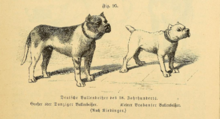Bull biters

Bullbiter or Bearbiter belonged to the mastiff-like dogs that were originally used to hunt defensive game.
In the Middle Ages, dogs of the bullbiter type were common in many European countries. In modern times they were still used as bastards and for “fighting bears” and for “ Podolian and Hungarian buffalo-ox hunt ” ( wisent ), as Hans Friedrich von Fleming wrote in 1719. During this time, however, there had been a development from pure hunting to a staged event for noble societies. Where no wild animals were available, bulls were used, which Fleming has already criticized as not humane. They were also known as butcher dogs and probably held cattle at cattle markets or during slaughter by biting into the animal's nose. In the German-speaking area, a distinction was made between two main types, the large Danziger and the small Brabanter Bullenbeisser. The latter is generally regarded as a pre-form of the boxer .
In England in the 16th to 18th centuries, powerful dogs were bred especially for bullbaiting (German: bull biting ), whose task it was to wrestle bulls in exhibition fights. These old English bulldogs from the 16th to 18th centuries were related to the continental bulldogs of that time, but not identical. While this form of animal fighting enjoyed great popularity in England and was a popular sport for people of all classes, it found less or less lasting resonance in German-speaking countries, as can be seen in the development of the Berlin Hetzgarten and the Hetztheater in Vienna.
At the beginning of the nineteenth century, Georg Franz Dietrich from the Winckell 1820 describes in his handbook for hunters, those entitled to hunt and hunting enthusiasts "the hounds to be used on bears" as follows:
“Bull or bear biters, a not too big, but strong, courageous dog race with thick, short heads. They pack everything they are rushed to, but are heavy. They are usually moused, d. H. to plug the ears; also cut off the rod briefly. Both of these happen before they are six weeks old. Because of their wickedness and malice they can easily become dangerous to humans and animals; for this reason it is not allowed in several countries to use them. "
Today's dog breeds , which can be traced back to mastiff-like dogs of the bullbiter type, are, for example, the English bulldog , the Ca de Bou and the German boxer .
Web links
Individual evidence
- ↑ Ludwig Beckmann (Ed.): History and description of the breeds of the dog. Volume 2. Vieweg, Braunschweig 1895, p. 5 .
- ↑ Hans Friedrich von Fleming in: The perfect German hunter. Main part 1. The other edition. Martini, Leipzig 1749, p. 170 (the first edition appeared in 1719).
- ↑ Otto Friedrich in: The noble dog rearing, care, training and treatment of his diseases. 7th edition. Self-published, Zahna 1889, p. 44.
- ↑ Hans Friedrich von Fleming in: The perfect German hunter. Main part 1. The other edition. Martini, Leipzig 1749, p. 171 (the first edition appeared in 1719).
- ^ Georg Franz Dietrich from the Winckell in: Handbook for hunters, those entitled to hunt and hunt lovers. Edited and edited by Johann Jacob von Tschudi . Brockhaus, Leipzig 1858, p. 188 (digitized from Google Books).

